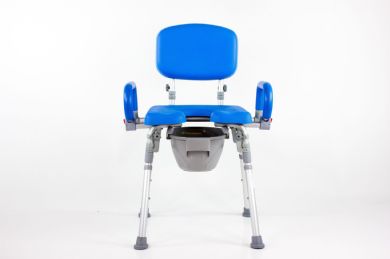
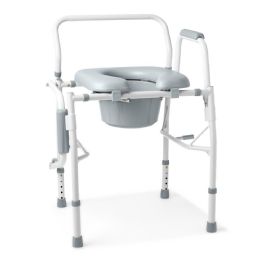
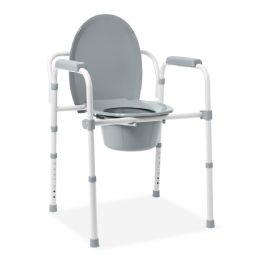
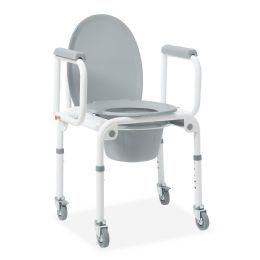
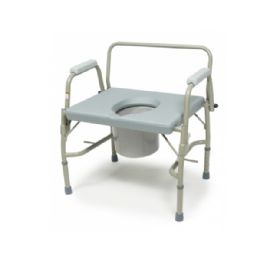

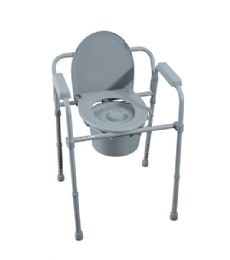
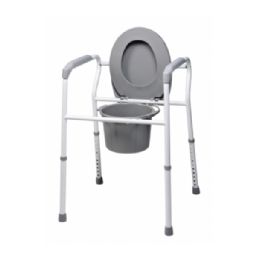
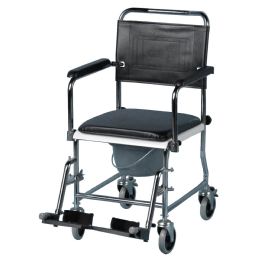
What is a Bedside Commode?
A bedside commode is configured as a chair that includes a regular toilet seat and lid, with some type of bucket, pail or waste receptacle fitted below the seat. While it is often placed beside the bed, it can actually be placed anywhere because it is lightweight and movable. Some commodes may feature wheels for rolling it from place to place, which should always be locked when it is in use.
Transportable commodes do not attach to any plumbing, so the waste collected must be dumped into a toilet to flush away. They provide much easier and more convenient toileting for individuals who cannot walk or get to a bathroom, and often include specially designed chair arms for simpler transfers and sitting/standing support.
Usually constructed in aluminum, steel or health grade PVC, some bedside commodes additionally offer specialized materials that help to inhibit the growth of bacteria. Standard household cleaners and disinfectants can also be used on bedside commodes to keep them clean and germ-free. Other highlights to look for include reinforced stress areas of the frame, height-adjustability to suit each individual user, and bariatric models that can accommodate much higher patient weights safely. Several models also feature angled seats, elongated seats, padded seats, angled armrests, bended backrests, splash guards, and bucket or pail lids to reduce spillage when emptying.
Can a Bedside Commode be Used for Other Purposes?
Aside from its use as a portable toilet, bedside commode frames are also often employed as a raised toilet seat, or as a toilet safety frame. Many designs are capable of fitting over an existing bathroom toilet to make it easier for people who cannot get up or down from a usual toilet seat height, or need the security and support of the frame’s arms and structure.
Portable commodes are often used as shower chairs, as well. Because they are regularly constructed with rust-resistant materials, many commodes remain durable and won’t break down with constant contact with water. Disabled, injured, aging or recovering individuals can be bathed with ease by using a bedside commode as they can sit in comfort, with caregivers having pretty open accessibility to thoroughly bathing their patient.
Who can Benefit from a Bedside Commode?
Many people enjoy the benefits a bedside commode can provide. Individuals who are bedridden, or who are recovering from surgery, injury or disease will be greatly assisted by providing toileting close to their bedside. People with certain disabilities or aging issues that are causing a higher risk of falling should also consider putting a bedside commode into place. They are helpful for those with incontinence issues, stroke, dementia and Alzheimer’s disease, Parkinson’s disease, ALS, and just about any disorder that causes unsteadiness, tremors, walking difficulties and mobility impairments.
The commode should always be placed as close to the user as possible. This may mean moving it throughout the day, dependent upon the user’s activity and location. While many users prefer the commode to be situated sideways against the bed, there are many individual factors that will help best determine where it should go for each unique user. Generally, if the user has weakness on a certain side of the body, the commode should be placed on their stronger side so that caregivers can assist the weaker side.
Be aware of tubing such as oxygen cannulae and IV tubes that can often get twisted or caught in the toileting process, causing potential accidents. It is usually best to gather them in front of the user, rather than trailing them behind.
Rehabmart is pleased to offer a wide selection of superior quality bedside commodes from outstanding vendors encompassing Invacare, Drive Medical, Medline, Independence Medical, Sammons Preston, North Coast and many more.
Hulet Smith, OT
Rehabmart Co-Founder & CEO
ck